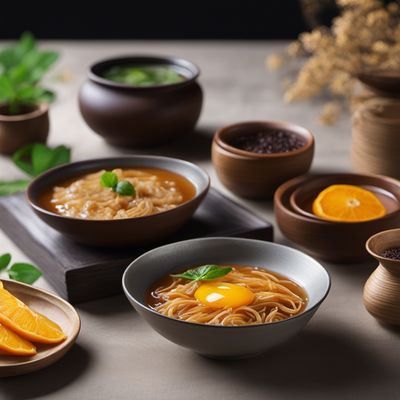
Ingredient
Trifoliate oranges
The Zesty Trio: Unveiling the Delights of Trifoliate Oranges
Trifoliate oranges are small, round fruits that resemble miniature oranges. They have a vibrant orange color and a bumpy, textured skin. The flesh is juicy and segmented, with a tart and sour taste that is reminiscent of lemons and limes. The texture is firm and slightly fibrous, providing a satisfying crunch. Trifoliate oranges are often used for their zest, which adds a bright and citrusy aroma to dishes.
Origins and history
Trifoliate oranges are native to East Asia, particularly China and Korea. They have a long history of cultivation and have been used in traditional Chinese medicine for centuries. Trifoliate oranges were introduced to Europe and North America in the 19th century and were primarily grown as ornamental plants due to their hardiness and attractive appearance.
Nutritional information
Trifoliate oranges are a good source of vitamin C, providing a significant boost to the immune system. They also contain dietary fiber, potassium, and antioxidants, making them a nutritious addition to a balanced diet.
Allergens
Trifoliate oranges are not known to be allergenic.
How to select
When selecting trifoliate oranges, look for fruits that are firm and heavy for their size. Avoid any with blemishes, mold, or soft spots. The skin should be vibrant orange and free from wrinkles. Additionally, choose fruits that have a strong citrus aroma, indicating their freshness.
Storage recommendations
Trifoliate oranges can be stored at room temperature for up to a week. For longer storage, refrigerate them in a plastic bag or airtight container for up to two weeks. Alternatively, the zest can be frozen for future use.
How to produce
Trifoliate oranges can be grown by amateur gardeners in regions with a suitable climate. They thrive in well-drained soil and require full sun exposure. It is best to propagate them from seeds or by grafting onto a compatible rootstock. Regular pruning and protection from frost during winter are essential for their successful cultivation.
Preparation tips
To prepare trifoliate oranges, wash them thoroughly and pat them dry. The zest can be grated or finely chopped and used to add a burst of citrus flavor to desserts, marinades, or dressings. The juice can be extracted and used in beverages, sauces, or vinaigrettes. The flesh can be segmented and enjoyed as a tangy snack or incorporated into salads and salsas.
Culinary uses
Trifoliate oranges are commonly used in marmalades, jams, and preserves due to their high pectin content. They also make a refreshing addition to cocktails, sorbets, and baked goods. The zest can be used to enhance the flavor of cakes, cookies, and savory dishes, providing a unique citrusy twist.
Availability
Trifoliate oranges are commonly cultivated in China, Korea, and parts of the United States, such as Florida and California.




